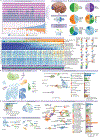Single-cell atlas reveals correlates of high cognitive function, dementia, and resilience to Alzheimer's disease pathology
- PMID: 37774677
- PMCID: PMC10601493
- DOI: 10.1016/j.cell.2023.08.039
Single-cell atlas reveals correlates of high cognitive function, dementia, and resilience to Alzheimer's disease pathology
Abstract
Alzheimer's disease (AD) is the most common cause of dementia worldwide, but the molecular and cellular mechanisms underlying cognitive impairment remain poorly understood. To address this, we generated a single-cell transcriptomic atlas of the aged human prefrontal cortex covering 2.3 million cells from postmortem human brain samples of 427 individuals with varying degrees of AD pathology and cognitive impairment. Our analyses identified AD-pathology-associated alterations shared between excitatory neuron subtypes, revealed a coordinated increase of the cohesin complex and DNA damage response factors in excitatory neurons and in oligodendrocytes, and uncovered genes and pathways associated with high cognitive function, dementia, and resilience to AD pathology. Furthermore, we identified selectively vulnerable somatostatin inhibitory neuron subtypes depleted in AD, discovered two distinct groups of inhibitory neurons that were more abundant in individuals with preserved high cognitive function late in life, and uncovered a link between inhibitory neurons and resilience to AD pathology.
Keywords: Alzheimer's disease; DNA damage response; cognitive impairment; cognitive resilience; cohesin complex; inhibitory neurons; neurodegeneration; single-cell transcriptomic atlas.
Copyright © 2023 The Authors. Published by Elsevier Inc. All rights reserved.
Conflict of interest statement
Declaration of interests L.-H.T. is a member of the Scientific Advisory Boards of Cognito Therapeutics, 4M Therapeutics, Cell Signaling Technology, and Souvien Therapeutics, which have no association to the work described in this manuscript.
Figures







Comment in
-
The AD odyssey 2023: Tales of single cell.Cell. 2023 Sep 28;186(20):4257-4259. doi: 10.1016/j.cell.2023.09.001. Cell. 2023. PMID: 37774675
References
-
- Johnson ECB, Dammer EB, Duong DM, Ping L, Zhou M, Yin L, Higginbotham LA, Guajardo A, White B, Troncoso JC, et al. (2020). Large-scale proteomic analysis of Alzheimer’s disease brain and cerebrospinal fluid reveals early changes in energy metabolism associated with microglia and astrocyte activation. Nat. Med 2020 265 26, 769–780. 10.1038/S41591-020-0815-6. - DOI - PMC - PubMed
-
- Scheltens P, Blennow K, Breteler MMB, De Strooper B, Frisoni GB, Salloway S, and Van Der Flier WM (2016). Alzheimer’s disease, www.thelancet.com. 10.1016/S0140-6736(15)01124-1. - DOI - PubMed
Publication types
MeSH terms
Grants and funding
- HHMI/Howard Hughes Medical Institute/United States
- R01 AG074003/AG/NIA NIH HHS/United States
- RF1 AG062377/AG/NIA NIH HHS/United States
- T32 GM087237/GM/NIGMS NIH HHS/United States
- P30 AG010161/AG/NIA NIH HHS/United States
- R01 AG081017/AG/NIA NIH HHS/United States
- RF1 AG054321/AG/NIA NIH HHS/United States
- U01 NS110453/NS/NINDS NIH HHS/United States
- R01 AG062335/AG/NIA NIH HHS/United States
- R01 AG067151/AG/NIA NIH HHS/United States
- U01 MH119509/MH/NIMH NIH HHS/United States
- R01 AG015819/AG/NIA NIH HHS/United States
- P30 AG072975/AG/NIA NIH HHS/United States
- U01 AG077227/AG/NIA NIH HHS/United States
- U01 DA053631/DA/NIDA NIH HHS/United States
- RF1 AG054012/AG/NIA NIH HHS/United States
- U01 AG046152/AG/NIA NIH HHS/United States
- R01 AG058002/AG/NIA NIH HHS/United States
- R01 HG008155/HG/NHGRI NIH HHS/United States
- T32 NS007433/NS/NINDS NIH HHS/United States
- U01 AG061356/AG/NIA NIH HHS/United States
- UG3 NS115064/NS/NINDS NIH HHS/United States
- R01 AG017917/AG/NIA NIH HHS/United States
- UH3 NS115064/NS/NINDS NIH HHS/United States
- R01 NS127187/NS/NINDS NIH HHS/United States
- RF1 NS129032/NS/NINDS NIH HHS/United States
LinkOut - more resources
Full Text Sources
Medical

